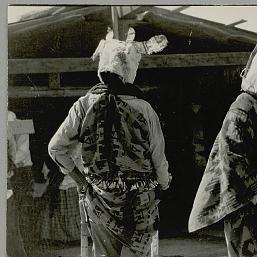Social and Political Structure
 The town, or barrio, is the largest political entity in Yaqui society. As with other aspects of their culture, town government represents fusion of European and aboriginal concepts. In the eight Yaqui towns established during the Mission period, the town was the fundamental unit of Yaqui life. Each town was governed by five groups: the church, the governors, the military, the keeper of traditions, and the fiesta makers. All five entities had different functions, yet they worked in concert with one another and were considered equal in authority. (Each of these five groups still exist in the Mexican Yaqui towns, but in the Arizona barrios, only the church and the keeper of traditions have been retained). Town government reflected the Yaqui ideal of cooperation and shared responsibility rather than individual power. General meetings of all of five groups were called when necessary to make decisions affecting the whole town or to decide disputes. In such cases, everyone was free to speak and a decision was reached only when there was consensus. If there was dissent, a decision was postponed or never reached. No overall tribal organization existed except during times of military conflict.
The town, or barrio, is the largest political entity in Yaqui society. As with other aspects of their culture, town government represents fusion of European and aboriginal concepts. In the eight Yaqui towns established during the Mission period, the town was the fundamental unit of Yaqui life. Each town was governed by five groups: the church, the governors, the military, the keeper of traditions, and the fiesta makers. All five entities had different functions, yet they worked in concert with one another and were considered equal in authority. (Each of these five groups still exist in the Mexican Yaqui towns, but in the Arizona barrios, only the church and the keeper of traditions have been retained). Town government reflected the Yaqui ideal of cooperation and shared responsibility rather than individual power. General meetings of all of five groups were called when necessary to make decisions affecting the whole town or to decide disputes. In such cases, everyone was free to speak and a decision was reached only when there was consensus. If there was dissent, a decision was postponed or never reached. No overall tribal organization existed except during times of military conflict.
Outside the political realm, religious brotherhoods played an important social role in the communities. These brotherhoods, termed cofradias, were organizations of laymen dedicated to the service of a Christian saint or other supernatural being. Although the concept of cofradia was introduced to the Yaqui by the Jesuit priests, after the expulsion of the Jesuits in 1767 the concept became fused with their indigenous concepts of ceremonial sodalities. One important sodality is that of the Fariseos, who represent the Pharisees or Judases who persecuted Christ. The Fariseos play an important role in the annual Easter re-enactment. Additionally, members of this sodality function much like that of the Pueblo clowns, acting with complete license and mocking every sacred institution and the social order.
Fariseos during the Easter re-enactment
Source - http://sirismm.si.edu/naa/24/mexico/00809200.jpg
Click on next page to continue.
